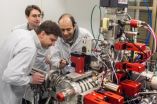(Press-News.org) Consumers are more willing to take risks and accept delays in exchange for greater benefits when they are able to compare products, according to a new study in the Journal of Consumer Research.
"Rationally speaking, consumer preferences should be the same whether their product choices are presented side-by-side and evaluated comparatively or presented one at a time and evaluated in isolation, but it makes a remarkable difference in consumer decision-making," write authors Christopher K. Hsee (University of Chicago Booth School of Business), Jiao Zhang (University of Miami), Liangyan Wang, and Shirley Zhang (both Shanghai Jiaotong University).
Consumers regularly face decisions such as whether to buy a current iPhone model today or wait six months for a newer and better model (a time preference dilemma), or whether to invest retirement money in a risk-free savings account or a risky mutual fund with higher expected returns (a risk preference dilemma).
In one study, consumers had to choose between two internet service plans. One featured a higher speed but wouldn't be available for three months; the other featured a lower speed but was available immediately. When both options were presented side-by-side, consumers were willing to pay significantly more for faster service with delayed installation. When they were presented with only one of the two options, there was a stark "preference reversal" and consumers were willing to pay significantly more for slower service with immediate installation.
Consider a financial services company offering both safe (lower expected return) and risky (higher expected return) investments. All investment options should be presented side-by-side to allow comparison if the company wants to encourage investors to choose riskier products with higher expected returns, while options should be featured individually to encourage investors to choose safe products.
"When consumers can compare products, they tend to prefer delayed or riskier options with greater potential benefits, but tend to value certain and immediate benefits when product comparison is not possible," the authors conclude.
###
Christopher K. Hsee, Jiao Zhang, Liangyan Wang, and Shirley Zhang. "Magnitude, Time, and Risk Differ Similarly between Joint and Single Evaluations." Journal of Consumer Research: June 2013. For more information, contact Christopher Hsee or visit http://ejcr.org/.
Comparison investing: Why are consumers more willing to take risks when they can compare products?
2013-03-05
ELSE PRESS RELEASES FROM THIS DATE:
Targeting diet products: Why are more independent consumers better at delaying gratification?
2013-03-05
Product benefits that occur later in time are more likely to appeal to more independent consumers than to those who are more group or family oriented, according to a new study in the Journal of Consumer Research.
"More independent consumers think of the future in abstract terms and perceive future events as happening in the more distant future, whereas consumers who are less independent think of the future in concrete terms and perceive future events as happening sooner," write authors Gerri Spassova (Monash University) and Angela Y. Lee (Kellogg School of Management, ...
Texas A&M research contributes to improved ultrasound imaging
2013-03-05
Ultrasound technology could soon experience a significant upgrade that would enable it to produce high-quality, high-resolution images, thanks to the development of a new key material by a team of researchers that includes a professor in the Department of Biomedical Engineering at Texas A&M University.
The material, which converts ultrasound waves into optical signals that can be used to produce an image, is the result of a collaborative effort by Texas A&M Professor Vladislav Yakovlev and researchers from King's College London, The Queen's University of Belfast and ...
On the trail of mucus-eaters in the gut
2013-03-05
This press release is available in German.
The microbiology team of David Berry, Alexander Loy and Michael Wagner from the Faculty of Life Sciences, in collaboration with scientists at the Max F. Perutz Laboratories (University of Vienna and the Medical University of Vienna) and with the help of NanoSIMS technology, has for the first time succeeded in directly observing microorganisms feeding on the intestinal mucosa. The results of this research project appear in the current issue of the prestigious journal "Proceedings of the National Academy of Sciences" (PNAS).
To ...
Homes in neighborhoods with protected open space bringing higher sale prices
2013-03-05
Homes in neighborhoods that incorporate protected open space command prices 20 to 29 percent higher than those without open space, according to a new study by a Colorado State University multidisciplinary research team that included Wildlife Conservation Society scientist, Sarah Reed.
Conservation development is an approach to the design, construction, and stewardship of a development that protects natural resources while also providing social and economic benefits to people. The properties in this study specifically incorporated protected open space into the design of ...
A window into Europa's ocean lies right at the surface
2013-03-05
PASADENA, Calif.—If you could lick the surface of Jupiter's icy moon Europa, you would actually be sampling a bit of the ocean beneath. So says Mike Brown, an astronomer at the California Institute of Technology (Caltech). Brown—known as the Pluto killer for discovering a Kuiper-belt object that led to the demotion of Pluto from planetary status—and Kevin Hand from the Jet Propulsion Laboratory (JPL) have found the strongest evidence yet that salty water from the vast liquid ocean beneath Europa's frozen exterior actually makes its way to the surface.
The finding, based ...
U of M researchers find wide variation in cesarean delivery rates among US hospitals
2013-03-05
MINNEAPOLIS/ST. PAUL (March 4, 2013) – Cesarean delivery is the most common surgery in the United States, performed on 1.67 million American women annually. Yet hospital cesarean rates vary widely according to new research from the University of Minnesota's School of Public Health.
The latest study, appearing today in Health Affairs, shows that cesarean delivery rates varied tenfold across U.S. hospitals, from 7.1 percent to 69.9 percent.
To arrive at their results, School of Public Health researchers examined hospital discharge data from a representative sample ...
Survey of clinicians: User satisfaction with electronic health records has decreased since 2010
2013-03-05
March 5. 2013 -- Survey results released today indicate that satisfaction and usability ratings for certified electronic health records (EHRs) have decreased since 2010 among clinicians across a range of indicators. Overall, user satisfaction fell 12 percent from 2010 to 2012. Users who are "very dissatisfied" increased 10 percent during the same time period.
The American College of Physicians (ACP) and AmericanEHR Partners revealed the findings in a presentation, "Challenges with Meaningful Use: EHR Satisfaction & Usability Diminishing," at the 2013 HIMSS Conference ...
Hope in stopping melanoma from spreading: Inhibiting protein prevents metastasis to lungs in mice
2013-03-05
SALT LAKE CITY – Researchers have identified a critical protein role in the metastasis of melanoma, the most serious form of skin cancer. Inhibition of the protein known as adenosine diphosphate ribosylation factor 6 (ARF6) reduces the spread of melanoma to the lungs in mice, according to a study published in the March 5 issue of Science Signaling online, suggesting that targeting ARF6 may be an effective approach to preventing melanoma metastasis.
Melanoma is the sixth most common cancer in the United States. Approximately one in 50 people will develop melanoma in their ...
Researchers discover gene that causes obesity in mice
2013-03-05
AURORA, Colo. (March 5, 2013) – Researchers have discovered that deleting a specific gene in mice prevents them from becoming obese even on a high fat diet, a finding they believe may be replicated in humans.
"When fed a diet that induces obesity these mice don't get fat," said Prof. James McManaman, Ph.D., lead author of the study and vice-chairman of research for Obstetrics and Gynecology at the University of Colorado School of Medicine. "It may be possible to duplicate this in humans using existing technology that targets this specific gene."
The two-year study, ...
New method for greenhouse gas predictions
2013-03-05
This press release is available in French.
Montreal, March 5, 2013 – Pulp and paper producers are among Canada's most important industries and also one of the largest producers of wastewater. Estimating the greenhouse gas emissions in this wastewater has become a priority for the industry.
Until now, greenhouse gas emission estimates have been limited by the mathematical models used to predict them. Researchers at Concordia University have recently developed a new dynamic method to better predict the emission content of these gases. Their findings, published in Environmental ...


